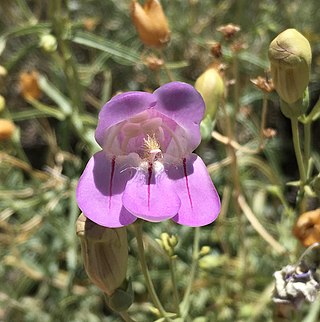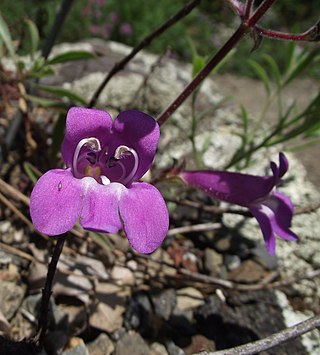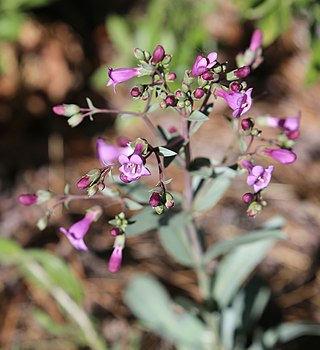
Penstemon albomarginatus is an uncommon species of penstemon known by the common name white-margined beardtongue. It is native to the deserts of southern Nevada and western Arizona, as well as in two desert washes in the Mojave Desert in California. It is a perennial herb with several erect stems emerging from a taproot in the sand, their base buried beneath the surface. The stem branches are hairless and somewhat waxy in texture, reaching up to about 35 centimeters tall. The oppositely arranged leaves are oblong or widely lance-shaped, pale green edged in white, and up to 5 centimeters long. The inflorescence produces several purplish-pink tubular flowers between 1 and 2 centimeters long surrounded at the bases by toothed, white-edged sepals. The flower has some hairs in the mouth, but the staminode is hairless. The flowers are pollinated by vespid wasps and probably other insects, such as carabid beetles.

Penstemon azureus is a flowering plant species known by the common name azure penstemon.
Penstemon caesius is a species of penstemon known by the common name San Bernardino beardtongue. It is endemic to California, where it is known from the San Bernardino and San Gabriel Mountains, as well as the southern mountains of the Sierra Nevada. It is a member of the flora on rocky slopes and in coniferous forests and alpine habitat in the mountains. It is a perennial herb with erect branches up to about 80 centimeters in maximum height. The lower branches may be woody, the upper hairless and waxy, and the inflorescence glandular. Most of the leaves are basal on the plant, rounded or oval, and up to about 4 centimeters long. The inflorescence produces purple-blue tubular flowers roughly 2 centimeters long. The flower has a glandular outer surface, a coat of hairs inside, and a hairless staminode. The flowers of this penstemon are pollinated by bees of genus Osmia, which feed on their nectar.

Penstemon centranthifolius is a species of penstemon known by the common name scarlet bugler. It is native to California and parts of Mexico, where it grows in many types of dry habitat from coast to desert, such as chaparral and oak woodland.
Penstemon cinicola is a species of penstemon known by the common name ash penstemon. It is native to northeastern California and southern Oregon, where it grows in forests and plateau habitat. It is a perennial herb with upright branches 40 centimeters (16 in) maximum height. The leaves are 3 to 6 centimeters long, linear in shape, folded lengthwise, and curved backwards. The inflorescence produces tubular flowers with wide lipped mouths. The flower is blue-purple in color, just under one centimeter long, and hairless except for hairs on the floor of the mouth and on the staminode.

Penstemon filiformis is an uncommon species of penstemon known by the common name threadleaf beardtongue. It is endemic to the Klamath Mountains of northern California, where it grows in forest and woodland, often on serpentine soils. It is a perennial herb growing up to half a meter tall, its stem hairy and woody toward the base. The leaves are very narrow, linear and rolled to threadlike, reaching up to 7 centimeters long, those low on the plant sometimes borne in clusters. The inflorescence produces hairless, tubular or funnel-shaped blue to purple flowers just over a centimeter in length.

Penstemon fruticiformis is a species of penstemon known by the common name Death Valley beardtongue. It is native to the western United States, where it is found growing in rocky scrub, woodlands, deserts and mountains of eastern California and western Nevada. It is known from scattered occurrences around Death Valley, and only one of the two varieties occurs on the Nevada side of the border. It is a perennial herb producing spreading, multibranched, hairless and waxy stems 30 to 60 centimeters tall. The thick leaves are generally lance-shaped, folded and rolled, and up to 6.5 centimeters in length. The inflorescence produces several white or pale pinkish-lavender flowers between 2 and 3 centimeters long. The mouth of the flower bears a stark, dark line on each of its three lower lobes, nectar guides for its pollinators which probably include native bumble bees.

Penstemon gracilentus is a species of penstemon known by the common names slender beardtongue and slender penstemon. It is native to the mountains and sagebrush plateau of northeastern California, western Nevada, and southern Oregon, where it grows in forest, woodland, and scrub habitat. It is a perennial herb producing upright branches to about 65 centimeters in maximum height, the stems developing woody bases. The leaves are up to 10 centimeters in length and linear or lance-shaped. The glandular inflorescence produces several tubular purple flowers up to 2 centimeters long. The mouth of each flower may be hairless or coated in long hairs, and the staminode usually has a coat of yellow hairs.

Penstemon labrosus is a species of penstemon known by the common name San Gabriel beardtongue. It is native to the Transverse Ranges of southern California, including the San Gabriel Mountains, and the Peninsular Ranges to the south, its distribution extending into Mexico. It grows in forest and woodland habitat. It is a perennial herb growing erect to about 70 centimeters tall. The long, paired leaves are linear in shape with rolled, untoothed edges, and reach over 8 centimeters in maximum length. The inflorescence produces bright red to orange or yellowish flowers 3 to 4 centimeters long. The upper lip is hood-shaped and the lower is divided into 3 narrow lobes which are sometimes reflexed. The flower is hairless, including the staminode.

Penstemon laetus is a species of penstemon known by the common names mountain blue penstemon and gay penstemon. It is native to the inland mountains of Oregon and California, where its distribution extends from the Klamath Mountains through the Sierra Nevada to the Transverse Ranges. It grows in forest, scrub, and other local mountain habitat. It is a perennial herb growing erect to about 75 centimeters tall, its base becoming woody. The leaves are linear to lance-shaped and up to 10 centimeters long. The glandular inflorescence bears blue or purple flowers up to 3.5 centimeters long. The wide-mouthed tubular or funnel-shaped flower is glandular on the outer surface and mostly hairless on the inside.

Penstemon papillatus is a species of penstemon known by the common name Inyo beardtongue.

Penstemon patens is a species of penstemon known by the common name Lone Pine beardtongue. It is native to the central Sierra Nevada of California and slopes and plateau to the east, its distribution extending just into Nevada. It grows in forest, woodland, and scrub habitat types. It is a perennial herb producing hairless, waxy stems up to about 40 centimeters tall. The thick, lance-shaped, gray-green, opposite leaves are up to 9 centimeters long and 2 wide. There are usually many leaves clustered around the base of the plant and smaller pairs higher on the stem. The inflorescence bears wide-mouthed tubular flowers up to 2 centimeters long with corollas in shades of lavender to magenta. The flower is mostly hairless except for the staminode which may have a coat of orange or yellowish hairs.
Penstemon personatus is an uncommon species of penstemon known by the common name closethroat beardtongue.

Penstemon procerus is a species of penstemon known by the common name littleflower penstemon. It is native to western North America from Alaska to California to Colorado, as far east in Canada as Manitoba, where it grows in mountain habitat such as meadows, often in alpine climates. This herbaceous perennial forms mats of herbage with some erect stems reaching about 40 centimeters in maximum height. There are several varieties which vary in morphology, some more decumbent than others, some of which are known commonly as pincushion penstemons for their matted forms. In general, the leaves are lance-shaped to oval, plentiful around the base of the plant with smaller ones arranged in opposite pairs along the stem. The inflorescence is made up of one or more clusters of tubular flowers with lipped, lobed mouths. Each flower is no more than one centimeter in length and is purple to blue in color, often with a white throat. The outside of the flower is generally hairless, while the inside may be lined with white or yellowish hairs.

Penstemon pseudospectabilis a species of penstemon. It's native to the southwestern United States, where it grows in desert and plateau habitat types, such as sandy washes, scrub, and woodland. The plant is generally a shrub growing to one meter, with many erect stems. The thin leaves are oval with wide, pointed tips and serrated edges. They are arranged oppositely in pairs, many are completely fused at the bases about the stem, forming a disc. The inflorescence bears tubular flowers with expanded, lobed mouths and glandular hairs on most surfaces, except the hairless staminode. The flower grows to 2.5 centimeters and is reddish pink.

Penstemon roezlii is a species of penstemon known by the common name Roezl's penstemon. It is native to Oregon, western Nevada, and adjacent sections of northern California, including the Klamath Mountains and Sierra Nevada, where it grows in sagebrush and forest habitat types. It is a hairy, erect perennial herb growing to a maximum height of 55 centimeters from a woody, branching base. The leaves are up to 7 centimeters long, linear to widely lance-shaped and often folded lengthwise. The glandular inflorescence bears wide-mouthed tubular flowers up to 2.2 centimeters long in shades of blue-purple. The flowers are mostly hairless except for thin glandular hairs on the outer surfaces.

Penstemon tracyi is a rare species of penstemon known by the common names Trinity penstemon and Tracy's beardtongue.

Penstemon utahensis is a species of penstemon known by the common names Utah beardtongue and Utah penstemon. It is native to the southwestern United States, where it grows in scrub, woodland, and canyons. It is a perennial herb growing erect to a maximum height near half a meter. The thick leaves are located around the base of the plant and in opposite pairs along the stem. The upper leaves are lance-shaped and often folded lengthwise, measuring up to 5.5 centimeters long. The showy inflorescence bears many bright red-pink flowers up to 2.5 centimeters in length. They are cylindrical, tubular, or funnel-shaped with wide, lobed mouths, and mostly hairless to slightly hairy and glandular.

Penstemon rhizomatosus is a rare species of flowering plant in the plantain family known by the common names Scheel Creek beardtongue and rhizome beardtongue. It is endemic to Nevada in the United States, where it occurs only in the Schell Creek Range of White Pine County.

Penstemon barrettiae is a species of flowering plant in the plantain family known by the common name Barrett's beardtongue or Barrett's penstemon. It is endemic to a small part of the Pacific Northwest of North America.

















